#stone of erech
Explore tagged Tumblr posts
Text

the stone doesn't even do anything...
#stone of erech#silmarillion#númenor#elendil#isildur#anarion#if you squint#comic#second age#numenor#tolkien#middle earth#lena-point#lord of the rings#lotr#fall of numenor#I hope you can still read the text#you might have to open it in a new tab
137 notes
·
View notes
Photo

Stone of Erech
"At the Stone of Erech they shall stand again and hear there a horn in the hills ringing." —Malbeth the Seer
Artist: Jonas De Ro TCG Player Link Scryfall Link EDHREC Link
#mtg#magic the gathering#tcg#$0.95#jonas de ro#stone of erech#the lord of the rings: tales of middle-earth#legendary#artifact
37 notes
·
View notes
Text
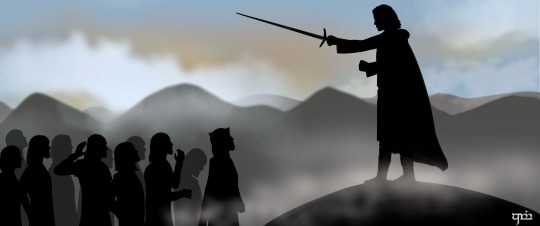
For at Erech there stands yet a black stone that was brought, it was said, from Númenor by Isildur; and it was set upon a hill, and upon it the King of the Mountains swore allegiance to him in the beginning of the realm of Gondor. But when Sauron returned and grew in might again, Isildur summoned the Men of the Mountains to fulfil their oath, and they would not: for they had worshipped Sauron in the Dark Years.
Then Isildur said to their king: “Thou shalt be the last king. And if the West prove mightier than thy Black Master, this curse I lay upon thee and thy folk: to rest never until your oath is fulfilled. For this war will last through years uncounted, and you shall be summoned once again ere the end.” And they fled before the wrath of Isildur, and did not dare to go forth to war on Sauron’s part.
-J.R.R. Tolkien, The Lord of the Rings, The Return of the King
The Life of Isildur 5/10
15 notes
·
View notes
Photo

This Erech guy REALLY likes to get stoned
39 notes
·
View notes
Text
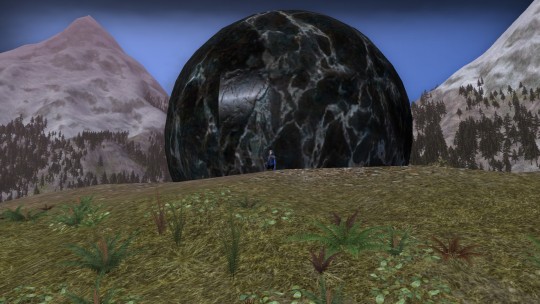
Very tiny Hobbit. Very big rock.
9 notes
·
View notes
Text
A listing for larger prints of this painting will be available soon! But I do still have some smaller sized prints available right now (links below! 💫)
Etsy: https://www.etsy.com/uk/listing/1172799386/
Folksy: https://folksy.com/items/8355655-THE-OATH-Tolkien-s-Middle-Earth-Inspired-Fine-Art-Print-of-Original-Painting

(^Full painting!)
Detail from: “The Men of the White Mountain swear allegiance to Isildur at the Stone of Erech”
Full painting available as a print from my Etsy shop :)
#silmarillion#lotr#stone of erech#jrr tolkien#lotr tolkien silmarillion#tolkien illustration#tolkien#the silmarillion#silm art#isildur#numenoreans#numenor#middleearth#middle earth#the lord of the rings#lotr fanart#lotrart#lord of the rings#fantasy landscape#fantasy art#print for sale#silmarillion print#art print#concept art#poster art#landscape illustration#fantasy illustration#illustrator#artist on tumblr#small art business
66 notes
·
View notes
Text
Aragorn at the stone of Erech: Behold my secret banner! You can't see it because it's too dark, but believe me it's inspiring as shit!
8 notes
·
View notes
Text
Armies of the Dead/heaven in myths and epic fantasy - and the magic horns behind them!
One of the most famous armies of dead soldiers? The Men of Dunharrow, the army of the dead from Lord of the Rings who broke their oaths and renewed them finally under Aragorn.
Let's do this!
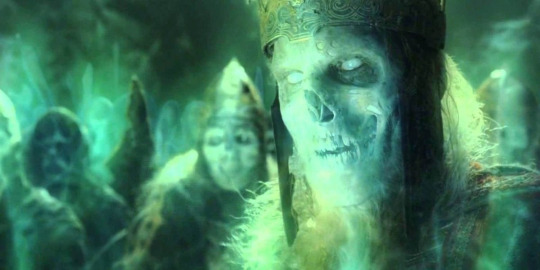
If you're a younger fantasy reader, or more modern, perhaps your introduction to this idea is in Robert Jordan's Wheel of Time with his magical horn that summons an army and legendary heroes to the field.
Some fans have said this is inspired by the Norse horn Gjallarhorn.
This is the horn trusted to Heimdallr to be blown to announce the beginning of Ragnarok and summon the Norse gods to the "thing" (thing is used in this case legitimately to mean - meeting, assembly, folkmoot) - in a moment like NORSE AVENGERS, ASSEMBLE!
This includes the Einherjar, the spirits of Norse warriors of honored dead who fell in battle and reside in Valhalla. But was there another possible influence?
Well, we know RJ was a Tolkien fan, and honestly who wouldn't be back in the days of early fantasy?
So, what of Tolkien's ghostly army of dead warriors? Well, if you haven't read the books, you might not know that Aragorn too summons his army of the dead with a magical horn (cut from the films). That's right.
You see, Elrohir (one of the sons of Elrond, also cut from the films) entrusts Aragorn with a silver horn to summon the dead with at the Stone of Erech to deal with them. Tolkien was a Norse buff and loved the old epics as well as poems.
So he was likely familiar with the stories just like with Gjallarhorn as well. But also, quite possibly the Song of Roland (a French epic poem) in where Roland and his forces are ambushed at Roncesvalles and are going to lose. In final desperation, Roland blows the horn, and the emperor hears the call. But the aid will not arrive in time (unlike the films and more modern stories where the heroes do arrive to save the day - this is cuz we like the just in the nick of time trope) so Roland dies blowing it one last time to hard in vengeance his temples burst (and he ascends to heaven), but...Charlemagne's army arrives in the aftermath and scatters the enemy. But, are there other armies of the dead? In fact, yes.
The Night Marchers of Hawaii who come with a warm wind, & the smell of sulfur, and the call of a conch shell to herald them. If you come upon this procession with torches in the night, and you are an enemy...time to RUN! Because if you watch them your eyes might be incinerated.
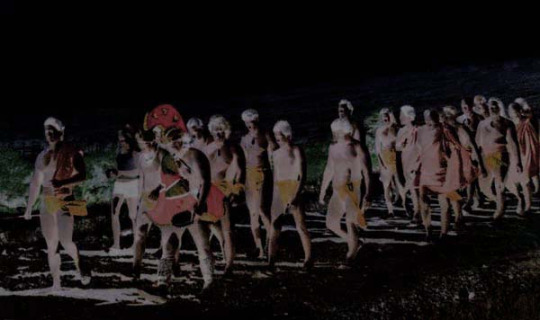
Then there is the Wild Hunt - a shared myth motif present through eastern, northern, and western European cultures. A ghostly army of the souls of dead men (and creatures) usually united under a leader (though this figure changes), Herne, Odin/Woden, Gwyn ap Nudd, Sigurd or Siegfried the Dragon Slayer, Theodoric the Great, onward. Now, they're not summoned by a horn, but in some tales their coming is announced by one.
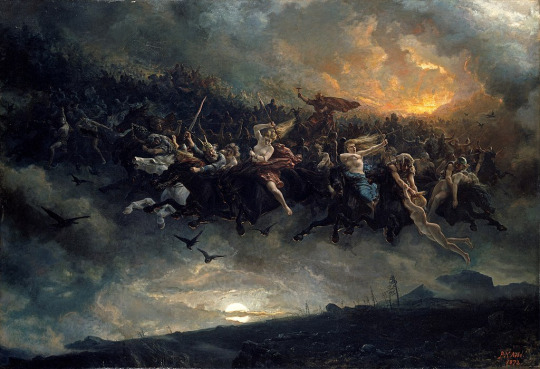
Now, an Indian cognate of the Wild Hunt and warriors in the service of heavens The Maruts.

The number of them vary from 20+ to over 180, to even more (yay conflicting mythological sources and arguments in ancient texts and interpretations).
But who are they? Companions and servants to Lord Indra, Slayer of the First Born of Dragons, and lord of the heavens and storms! So, fittingly, these warriors are very...storm themed. Violent, aggressive, expert combatants armed with lightning weaponary, and golden chariots to fly through the clouds on. Their war crys and battle sounds are like thunder. Their blows would split clouds (sounding thunder) and would hunt the enemies of Lord Indra and slaughter demons/monsters.
Interestingly they are often associated as the sons (children) of Rudra (the Rig Vedic storm and wind god). However, there is another group that often gets that association (obviously so), the Rudras.
The Rudras are similar in (some) regards to the Maruts but not all. They aid Vishnu in his battles against demons and are clad in lion-skins, and wear serpents around their necks. A crescent moon adorns their foreheads, and they wield golden tridents and carry a skull in one hand they wear necklaces of lightning illuminated clouds (how's that for bling bling?), and are monstrously feral in battle. Lord Shiva can call them with a blow of a conch shell/horn.
Their overlap, association with the Maruts is because of some etymology and shared functions as they too are a divine/spiritual/demigod group of heavenly warriors to aid the good and destroy evil - demons/adversaries, and the root word in their name means the roarers, thunderers, or the shouters - and this is also mentioned of the Maruts.
Are these all there are for legendary armies of the dead, of gods/heaven to be summoned to the field or aid? No. But, it's rainy, I'm a little messed up (mental health and meds), and tired.
So I'm going to bow out and read and study for Tremaine 3 and leave this minor comparative thread here for folks into this stuff.
#armies of the dead#The Men of Dunharrow#myths and legends#folklore#lord of the rings#magic horns#wheel of time#robert jordan#Gjallarhorn#Heimdallr#Norse gods#einherjar#valhalla#tolkien#aragorn#elrohir#night marchers#night marchers of hawaii#wild hunt#odin#woden#gwyn ap nudd#siegfried the dragonslayer#theodoric the great#Maruts#Lord Indra#Rudra#Rudras#Vishnu#Shiva
15 notes
·
View notes
Text

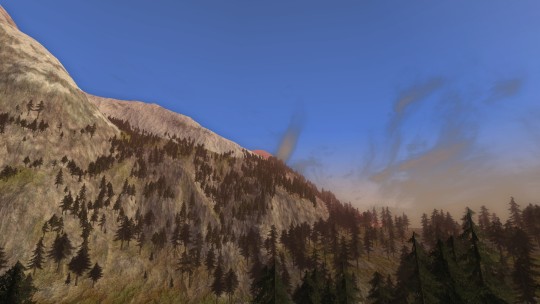
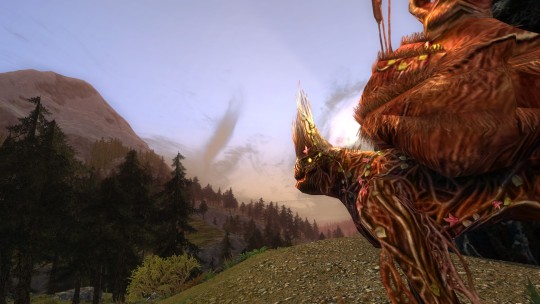

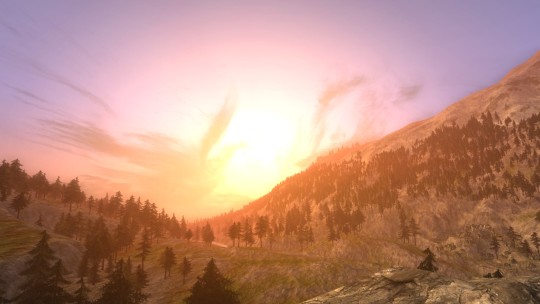
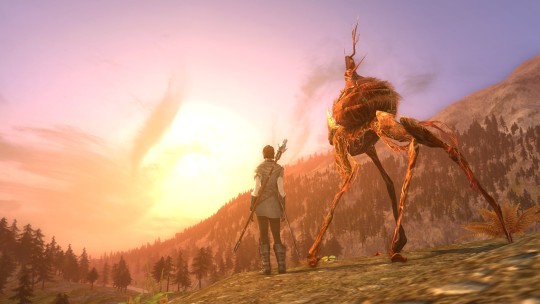
Erech Stone, me and my son Boogie!
23 notes
·
View notes
Text
What I want to see in the Rings of Power:
Sauron finding out about Shelob and thinkin, yea, best guard dog ever
Elrond building Imladris
Weathertop. Messenger riding past it or something. Just a little easter egg
Building / settling in Arnor
That awkward moment when Elrond has to ask Galadriel for Celebrian's hand
Elrond meeting Elendil and kids, and thinking they look just like his brother Elros
Just give me Celeborn meeting Galadriel again and the first thing he does is looses his sh*t over everything she's done
Isildur bringing the stone of Erech from Númenor, because how???
Just more Middle-earth
#lotr#rings of power#lotr amazon#tolkien#jrrtolkien#middle earth#lord of the rings#elrond#galadriel#celeborn#isildur#elendil#the rings of power#númenor#all the feels
73 notes
·
View notes
Text
“The power and centrality of the first woman-God is one of the best-kept secrets of history. We think today of a number of goddesses, all with different names—Isis, Juno, Demeter —and have forgotten what, 5,000 years ago, every schoolgirl knew; no matter what name or guise she took, there was only one God and her name was woman.
The Roman lawyer Lucius Apuleius was skillfully recycling the whole compendium of contemporary clichés in his portrait of "the Goddess" as she spoke to him in a vision:
I am nature, the universal mother, mistress of all the elements, primordial child of time, sovereign of all things spiritual, queen of the dead... Though I am worshipped in many aspects, known by countless names, propitiated with all manner of different rites, yet the whole round earth venerates me.
Later ages dismissed accounts of Goddess-worship as "myths" or “cults." But since Sir Arthur Evans, discoverer of the lost Minoan civilization at the turn of this century, stated that all the innumerable goddess-figures he had discovered represented "the same Great Mother... whose worship under various names and titles extended over a large part of Asia Minor and the regions beyond," modern scholarship has accepted that "the Great Goddess, the 'Original Mother without a Spouse’, was in full control of all the mythologies" as "a worldwide fact."
Nor was this an isolated or temporary phenomenon. Commentators stress the prominence and prevalence of the Great Mother Goddess as an essential element from the dawn of human life. From its emergence in the cradleland of the steppes of southern Russia her worship ranged geographically throughout the Mediterranean, the Indus Valley, and Asia as far as China, to Africa and Australia. Historically the span is even more startling:
25,000-15,000 B.C.—with the so-called "Venus figurines" of stone and ivory in Europe, of Nile mud in Egypt, "the Great Mother... bursts on the world of men in overwhelming wholeness and perfection."
12,000-9000 B.C.—in Dolni Vestonie, iechoslovakia, and Shanidar, Iraq, ceremonial burials of bodies coated in red ocher, commonly associated with Goddess worship.
7000 B.C.—in Jericho, the first shrines to the Mother Goddess.
6000 B.C.—the village settlement of Catal Huytik in Turkey, a site of only thirty-two acres, contains no less than forty shrines to the Goddess, in three incarnations as maiden, mother and crone.
5000 B.C.—a statuette from Hacilar in Turkey shows the Goddess in the act of making love.
4000 B.C. —the first written language appears on the temple of the Goddess under her title of Queen of Heaven at Erech (modern Urak) in Sumeria.
3000 B.C.—she now appears everywhere in the known world, in statues, shrines and written records.
200 B.C.—tribal Celts send their own priests of the Goddess to the great sacred festival of Cybele in Anatolia.
A.D. 200— at Tralles, in western Anatolia, a woman called Aurelia Aemiliana erects a carving at the temple of the Goddess, recording that she has duly performed her sexual service (sacred intercourse in honor of the Goddess) as her mother and all her female ancestors have done before her.
A.D. 500— Christian emperors forcibly suppress the worship of the Goddess and close down the last of her temples.
As this shows, the sacred status of womanhood lasted for at least 25,000 years— some commentators would push it back further still, to 40,000 or even 50,000. In fact there was never a time at this stage of human history when woman was not special and magical.
As the struggle for survival eased by degrees into the far harder struggle for meaning, woman became both focus and vehicle of the first symbolic thought. The French archaeologist Leroi-Gourhan solved a riddle of the early cave paintings that had defeated anthropologists of more puritanical cultures when he revealed that the recurrent and puzzling "double-eye" figure was a symbol of the vulva. Similarly in a remarkable sculpted frieze of animal and human figures at Angles-sur-l'Anglin, the female forms are represented by pure abstract triangles of women's bodies, with the sexual triangle prominently emphasized.
How did woman assume from the first this special status? One source of it was undoubtedly her moon-linked menstruation and the mystery of her nonfatal yet incurable emission of blood. Another was her close and unique relation to nature, for as gathering gave way to planned horticulture, women consolidated their central importance as the principal food producers. But the real key lies where the exaggerated breasts and belly of the earliest images of woman direct us to look, in the miracle of birth. Before the process of reproduction was understood, babies were simply born to women. No connection was made with intercourse (to this day Australian Aboriginals believe that spirit children dwell in pools and trees, and enter any woman at random when they wish to be born). Men, so it seemed, therefore had no part in the chain of generation. Only women could produce new life, and they were revered accordingly: all the power of nature, and over nature, was theirs.”
-Rosalind Miles; Who Cooked the Last Supper? The Women’s History of the World
#radblr#radfem#radical feminism#radical feminist safe#radical feminists do interact#radical feminists do touch#radical feminists please touch#feminism#feminist literature#who cooked the last supper#herstory#womens history#radical feminists please interact#radical feminist community#radical feminist literature#radical feminist theory#radical feminst#feminist library
8 notes
·
View notes
Text
The Captain and the Queen
by evocates
Three years after she was crowned the Queen of Gondor, Arwen finds Boromir in a small village near the Stone of Erech. Finding him seems easy when compared to her new Quest of bringing the Son of Gondor back home. Subtitled “An Exploration of the Problems of a Postwar Gondor”.
Explicit, No Archive Warnings
Words: 32,842
#lotr#elrond's favorites#aragorn/arwen#aragorn/boromir#arwen#boromir#aragorn#faramir#arwen/boromir#boromir lives au#polyamory#fourth age
6 notes
·
View notes
Text
In India the Goddess Sarasvati was honored as the inventor of the original alphabet, while in Celtic Ireland the Goddess Brigit was esteemed as the patron deity of language. Texts revealed that it was the Goddess Nidaba in Sumer who was paid honor as the one who initially invented clay tablets and the art of writing. She appeared in that position earlier than any of the male deities who later replaced Her. The official scribe of the Sumerian heaven was a woman. But most significant was the archaeological evidence of the earliest examples of written language so far discovered; these were also located in Sumer, at the temple of the Queen of Heaven in Erech, written there over five thousand years ago. Though writing is most often said to have been invented by man, however that may be defined, the combination of the above factors presents a most convincing argument that it may have actually been woman who pressed those first meaningful marks into wet clay.
-Merlin Stone, When God Was a Woman
15 notes
·
View notes
Text

Priorities
#that’s a great idea Isil!#it’ll make a great platform to curse oathbreakers one day#probably should’ve saved more useful things though#how bout some of those dancing Numenorean bears?#Isildur#elendil#stone of erech - wtf is that anyway#lotr rings of power#rings of power#trop
67 notes
·
View notes
Text
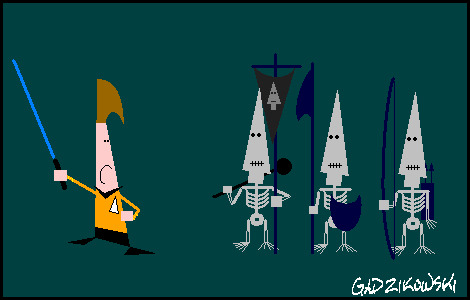
Last year (until my first tumblog vanished for a time), Dracula Daily inspired me to do something I’d considered before: Lord of the Rings Daily, following the events of the War of the Rings by calendar date from September 23 TA 3018 till the destruction of the Ring March 25 TA 3019. This will be following Appendix B so, like DD, not all days will have entries. And there’s a twist: it’s being done in my triangle figure cartoons instead of in book excerpts, and mashed up with the fandom crossover multiverse featured in my fancomic The Hero of Three Faces. There will be unique elements of both the novels and the movies.
March 8: Aragorn (James T. Kirk) walks the Paths of the Dead to the Stone of Erech and, as the true king, enlists the cursed shades there (skeleton war skeletons) against the forces of Mordor.
I thought of several possibilities I didn't like to give franchise faces to the cursed dead. Zombies, from any of several franchises? I didn't think they'd look much different from the shades in the movies. The ghosts of Ghosts? A little too silly even for me. Though you might think that of what I finally did. art reference
2 notes
·
View notes
Text
Cerphedis has walked the Paths of the Dead and finally reached Gondor! I've attempted to put together a Gondorian outfit in honor of her homecoming.
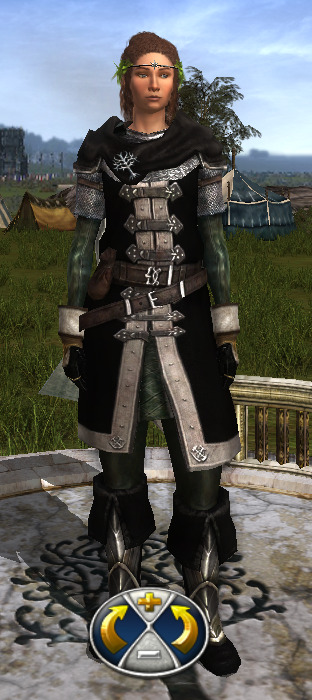


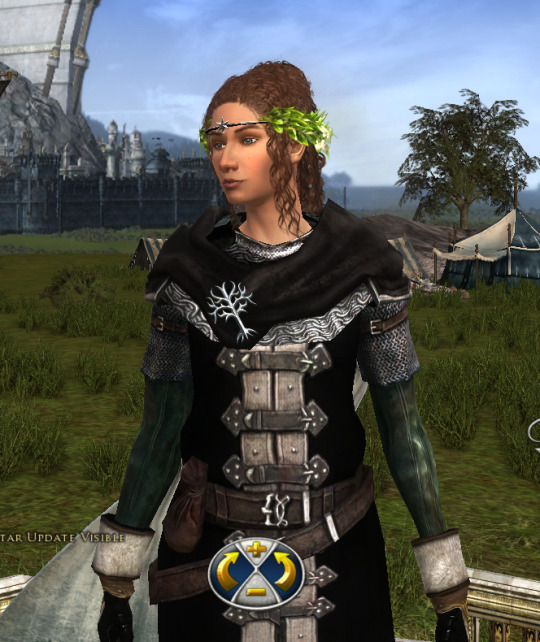

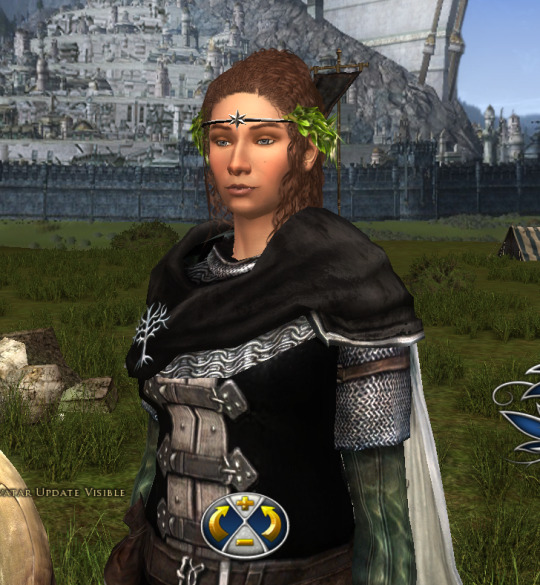
She's wearing Hyrde-Breost, dyed black; Lenni's old Decisive Cloak of the Citadel Guard Captain (or was this one Corbous' old cloak? Someone was kind enough to leave it in the wardrobe, for which Cerphedis thanks them); Medium Nadhin Shoulders with a lovely White Tree pin or embroidery or something; Reinforced Leather Dunlending Boots, dyed black; Argent Dwarf-Make Gloves, dyed black; and the Groom's Myrtle Circlet from the Midsummer festival. It'll do for now, but it still needs some work...

Ah, the grandeur of the White Mountains behind her, and...oh, what's this big marble?
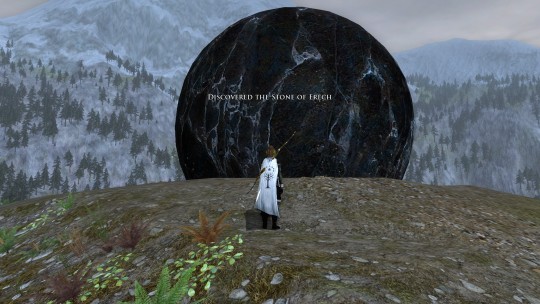
When I say homecoming, though, I don't think this specific part of Gondor (the Blackroot Vale) is where she's actually from. Maybe just further southwest, beyond Dol Amroth, maybe Pinnath Gelin or thereabouts; but for the moment I'm leaning towards her home being in Far Anórien. Off in this direction, on the other side of the Ered Nimrais...
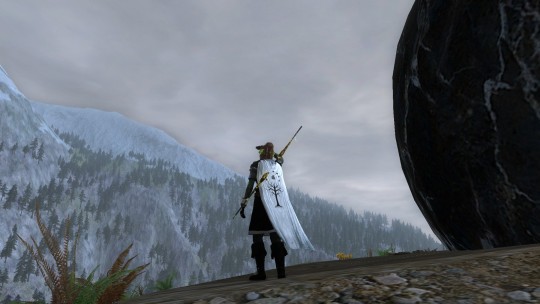
Meanwhile, while she was at the Stone of Erech, she met a Swan Knight! And his Loyal Horse!
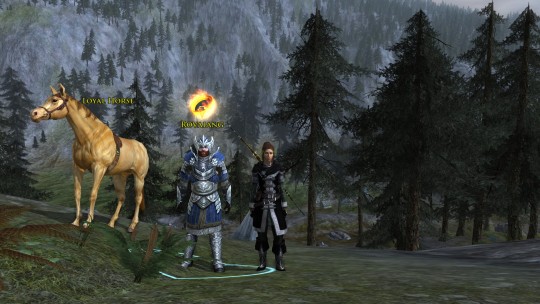
She also pouted about not being able to acquire all the lovely Gondorian-style dresses as cosmetics. Can't a girl just wear something half as nice as the NPCs get?
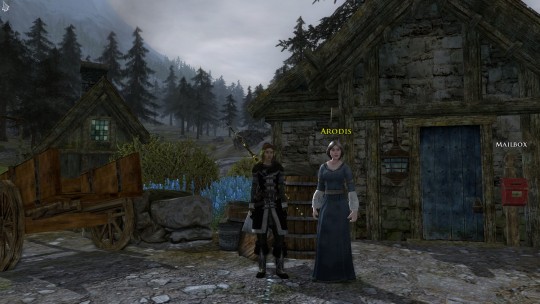

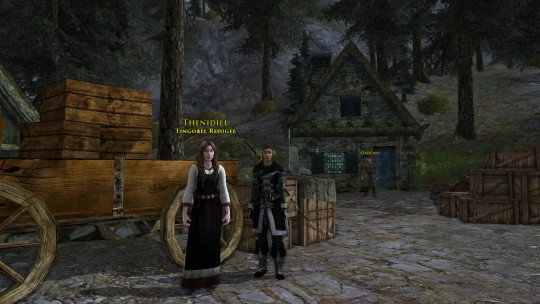
Ah, but then I did see one NPC in a dress that's actually in my wardrobe! (It's the Dress of the Anórien Autumn, I think from the fall festival, and this only strengthens my case that Cerphedis is from Far Anórien rather than West Gondor...) I can't dye it quite that dark a blue as the NPC version, but...Cerphedis is comforted knowing she at least has one proper Gondorian dress, just in case she gets summoned to, like, the King's wedding or something.
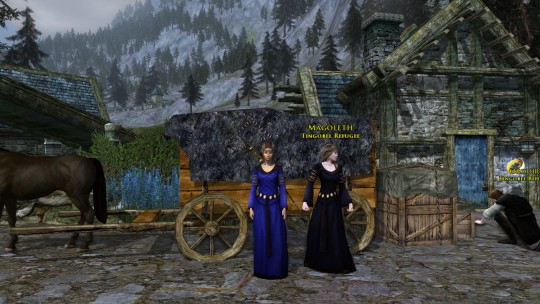
She still absolutely needs one of their cute slouchy berets, though.

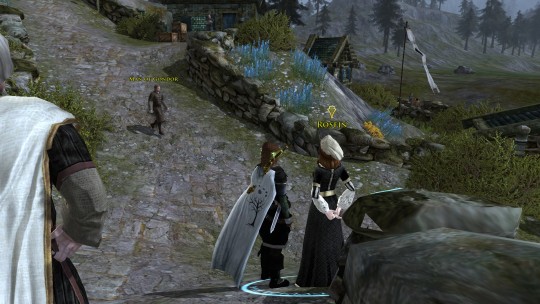
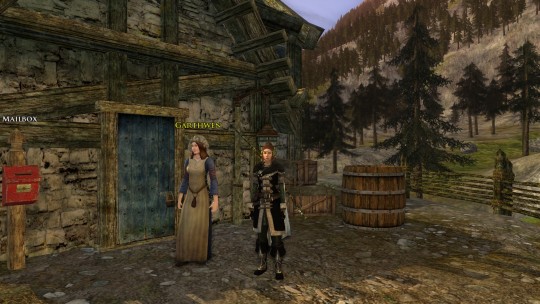
11 notes
·
View notes